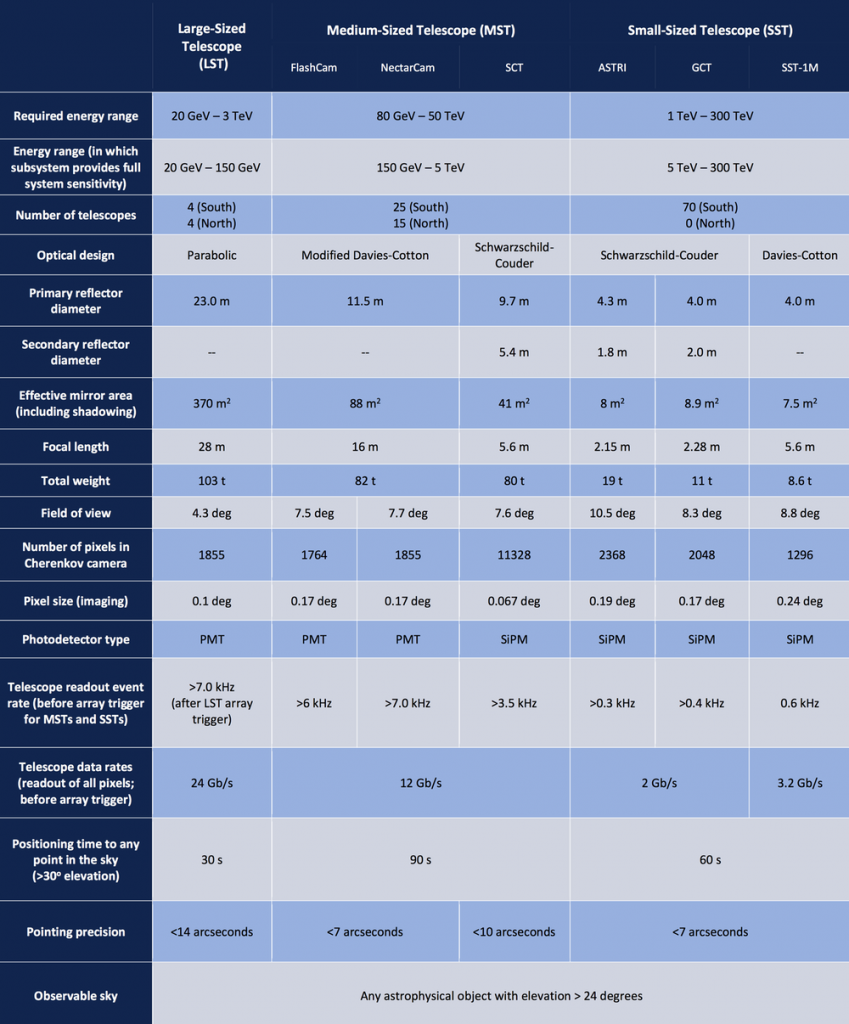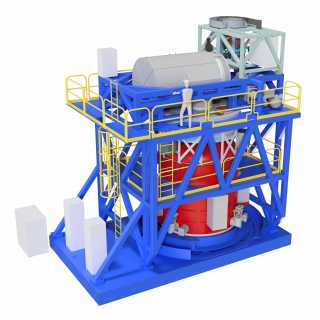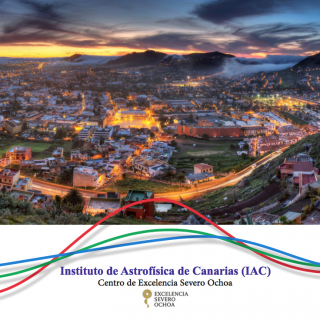Related grants:
General
What is CTAO?
CTAO is a large-scale global project to build a new generation of Cherenkov telescopes dedicated to the study of the Universe in very high-energy gamma-ray. It will be the largest, most sensitive and advanced instrument ever built for gamma-ray astronomy and the first ground-based observatory of its kind open to the world-wide astronomical and particle physics community.
The observatory will be located on two sites, each in a hemisphere. In the north, the location of CTAO is at the Observatorio del Roque de los Muchachos, of the Instituto de Astrofísica de Canarias (IAC), on the island of La Palma (Spain). In the southern hemisphere, CTAO is located in the Paranal Observatory of the European Southern Observatory (ESO), in the Atacama Desert (Chile).
CTAO will host three types of telescopes: Large-Sized Telescopes (LSTs), Medium-Sized Telescopes (MSTs) and Small-Sized Telescopes (SSTs) to cover a wide range of gamma radiation reaching from 20 GeV up to 300 teraelectron volts (TeV). The plan for the northern site includes 4 LST and 9 MST, while the southern site will feature all three telescope types: 4 LST, 25 MST and 70 SST. Overall, CTAO will have unprecedented accuracy and will be 10 times more sensitive than existing instruments.

The planning for the construction of the Observatory is managed by the CTAO gGmbH, which is governed by the CTAO Council made up of shareholders and associate members from a growing number of countries. The CTAO gGmbH works in close collaboration with the CTAO Consortium, which includes more than 1,400 scientists and engineers from 31 countries involved in the scientific and technical development of CTAO. An intergovernmental agreement is being prepared for the construction and subsequent operation of the observatory, for which a European Research Infrastructure Consortium (ERIC) is foreseen.
The construction of CTAO will have a total cost of more than 200 million euros, of which it is estimated that 90 million will be dedicated to the telescopes that are being installed in La Palma. The CTAO-North array, which is expected to come into operation in 2024, will have an estimated investment, both in purchases of goods and services and in hiring personnel, of more than 2 million euros per year.
The IAC actions in the CTAO project are funded by the projects "The four Large Size Telescopes (LST) of the CTA-North in the ORM" reference ESFRI-2017-01-IAC-12 and "Spanish contribution to the first five Medium Size Telescopes (MST) of the CTA-North in the ORM" reference ESFRI-2020-01-IAC-12, of the Ministry of Science and Innovation, 85% co-financed with European Regional Development Funds (ERDF) of the Operational Program for Intelligent Growth 2014- 2020; with co-financing from Canary Islands Development Funds (FDCAN), from the Island Council of La Palma (2016-2018), co-financing from the Government of the Canary Islands, through the Canary Islands Agency for Research, Innovation and Information Society (ACIISI); and from the General State Budget of the Ministry of Science and Innovation through the contribution of the transitional phase of the CTAO.
Science with CTAO
Ground-based gamma-ray astronomy is a young field with enormous scientific potential. CTAO will be sensitive to the highest-energy gamma rays, making it possible to study the physical processes at work in some of the most violent environments in the Universe.
CTAO will be a unique data source that will not only allow a deep and precise understanding of the already known objects and mechanisms of the Universe, but will also be able to detect new kinds of gamma-ray emitters and new phenomena, and will bring revolutionary discoveries in fundamental physics.
In our Galaxy, CTAO will be able to observe:
- Remnants of supernova explosions (SNR) and new pulsar wind nebulae (PWNe), which will allow us to delve into the origin of cosmic rays.
- New binary systems composed of two stars or formed by a star and a compact object (like neutron star or black hole).
Beyond the Milky Way, CTAO will be able to detect:
- The most luminous cosmic explosions, named gamma-ray bursts, in their initial phases.
- Active galactic nuclei (AGNs), some of which are still undetected in the gamma-ray regime.
- Star-forming galaxies, including so-called star-burst galaxies.
- Clusters of galaxies, which are promising targets to detect dark matter, as well as to investigate cosmicray acceleration.
Gamma rays detected with CTAO may also provide a direct signature of dark matter, evidence for deviations from Einstein’s theory of special relativity and more definitive answers to the contents of cosmic voids, the empty space that exists between galaxy filaments in the Universe.

CTAO Technology
CTAO will not detect gamma rays directly, as these actually never reach the earth's surface, but "Cherenkov light". Gamma rays interact with the Earth's atmosphere, producing cascades of subatomic particles that travel at higher speeds than light in the air. This rain of very high-energy charged particles generates a blue light cone called Cherenkov radiation. The duration of the light pulse is one billionth of a second and its brightness is too weak to be detected by the human eye. However, CTAO will be able to efficiently capture this type of radiation thanks to its large light-collecting mirrors and ultra-sensitive detectors.
LSTs are designed to capture brief, low-energy gamma ray signals (20 GeV - 3 TeV). They are 45 m high and weigh about 100 tonnes. The mirrors are 23 m in diameter, while the cameras will have a field of view of 4.5 degrees. They are able to re-position to a new target in the sky within 20 seconds.
The MSTs cover the middle of the CTA's energy range (80 GeV - 50 TeV). They are 27 m high and 80 tonnes in weight. The mirrors of the MSTs are 12 m in diameter and the field of view of their cameras is 7.5-7.7 degrees.
The SSTs are sensitive to the highest energy gamma rays (1-300 TeV). Their mirrors are about 4 m in diameter and their cameras have a wide field of view of 8-10 degrees. They are 9 m high and weigh between 9 and 19 tonnes. The SSTs will be spread out only in the southern hemisphere.

In total, CTAO will use more than 7,000 highly-reflective mirror facets (90 cm to 2 m diameter) to focus light into the telescopes' cameras. The cameras will use high-speed digitalization and triggering technology capable of recording shower images at a rate of one billion frames per second and sensitive enough to resolve single photons.
It will have photomultiplier tubes (PMTs) and silicon photomultipliers (SiPMs) for a total of more than 200,000 ultra-fast pixels responsible for converting the light into an electrical signal that will then be digitized and transmitted. SiPMs can operate during high levels of moonlight, improving the CTA's efficiency in collecting Cherenkov light during moonlight conditions.
CTA is a Big Data project. The Observatory is expected to generate approximately 100 petabytes (PB) of data in the first five years of operations.
Project Status
The project to build the CTAO is well-advanced: the prototype of the Medium-Size Telescope and the three proposed designs of the Small-Size Telescope have achieved "first light", and the prototype of the Large-Size Telescope, the LST-1, was inaugurated in October 2018. These prototypes should be tested before being considered for acceptance by the CTAO.




